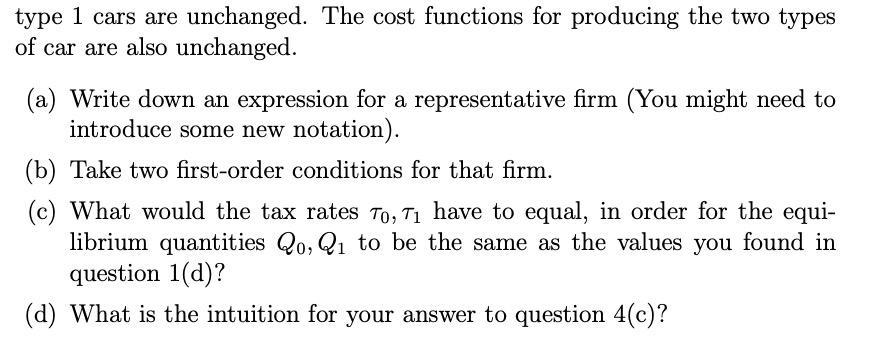Answered step by step
Verified Expert Solution
Question
1 Approved Answer
In the fourth setup there are only two firms, but both of them provide both types of car. You might think of this as



In the fourth setup there are only two firms, but both of them provide both types of car. You might think of this as the two firms competing against each other in two markets. Each firm chooses two quantities to provide, given the two quantities chosen by the other firm. The two firms are identical. Demand functions for the total quantity of type 0 cars, and for the total quantity of type 1 cars are unchanged. The cost functions for producing the two types of car are also unchanged. (a) Write down an expression for a representative firm (You might need to introduce some new notation). (b) Take two first-order conditions for that firm. (c) What would the tax rates To, T1 have to equal, in order for the equi- librium quantities Qo, Q1 to be the same as the values you found in question 1(d)? (d) What is the intuition for your answer to question 4(c)? There are two types of car, distinguished by how fuel efficient they are. Type 0 is the less fuel efficient type, and type 1 is the more fuel efficient. The inverse demand curves for the two types of car are: Po = 250 Qo Q1/2, P = 120 Q1 Qo/2. (1) Cost functions are Co(Qo) = 50Q0, C:(Q1) = 20Q1 (2) respectively. 1. Until question 5, we consider a "feebate" or "Clean Car Discount". That generally means there would be a subsidy on the purchase of some cars, and a tax on others, but in the following analysis it will be possible to have taxes on both or subsidies on both. In the current question, assume that there are two monopolies, one for type 0 cars and one for type 1 cars. Mathematically, this is equivalent to a Cournot duopoly with differentiated goods. (a) Let type 0 cars be taxed at To = 20 per car sold, and type 1 cars be subsidised at 20 per car. To keep the notation consistent between the two types, this subsidy will be represented as a negative tax: T1 = -20. The profits of the monopolist for type 0 cars are (250- 50- 20 - Qo - Q1/2)Qo- Write down an expression for profits of the monopolist selling type 1 cars. (b) Take first-order conditions for the two monopolists. (c) Simultaneously solve your first-order conditions to find the equilibrium quantities sold of the two types of car. (d) What would To and T1 have to be set to, for the equilibrium quantitites to be Qo = 60, Q1 = 60? Note that while this is a bit different conceptually from what you have done before, it is simpler mathematically. Instead of having to simultantaneously solve the two conditions, you should be able to solve them one-by-one. Remember to replace -20 with -To in the expression for profits from type 0, and +20 with -Ti in the profits for type 1.
Step by Step Solution
★★★★★
3.46 Rating (169 Votes )
There are 3 Steps involved in it
Step: 1
ANSWE...
Get Instant Access to Expert-Tailored Solutions
See step-by-step solutions with expert insights and AI powered tools for academic success
Step: 2

Step: 3

Ace Your Homework with AI
Get the answers you need in no time with our AI-driven, step-by-step assistance
Get Started


